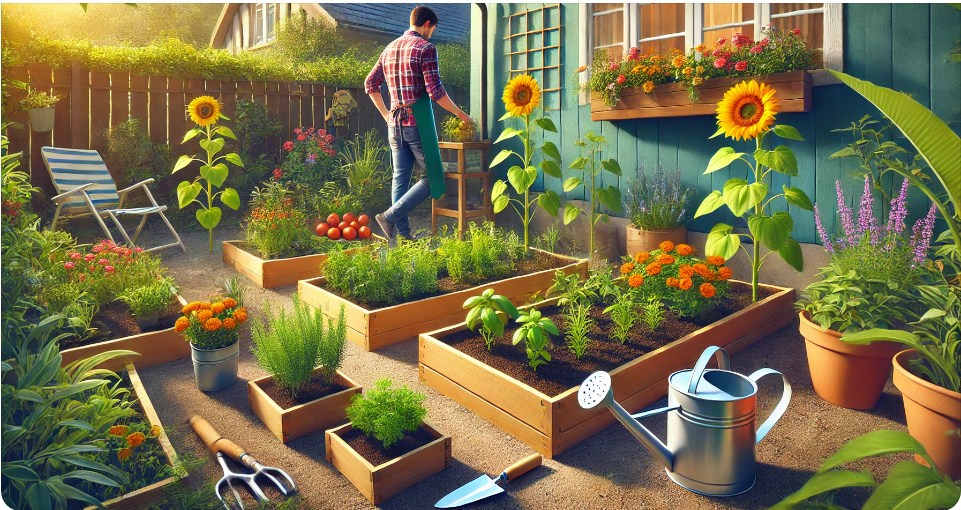Starting a home garden is one of the most fulfilling and rewarding hobbies you can embrace. Whether you’re looking to grow your own herbs, cultivate a flower bed, or simply add more greenery to your home environment, gardening offers a wide range of physical, mental, and emotional benefits.
In this guide, we’ll take a step-by-step look at how beginners can successfully start a garden at home. From choosing the right location to understanding soil and selecting plants, this article has everything you need to know.
Benefits of Gardening at Home
Before diving into the practical steps, it’s important to understand why home gardening is worth your time:
-
Stress relief: Spending time in nature can significantly reduce anxiety.
-
Physical activity: Gardening involves moderate exercise that helps keep you fit.
-
Food security: Growing herbs and vegetables ensures you have fresh produce at home.
-
Aesthetic value: A well-maintained garden enhances the beauty of your surroundings.
Step 1: Assess Your Space
Start by examining the space you have available. It could be a backyard, a balcony, a patio, or even a windowsill. Take note of the following:
-
Sunlight exposure: How many hours of sunlight does the area receive daily?
-
Wind conditions: Is the area too windy? Some plants don’t fare well in constant breeze.
-
Drainage: Does water pool in one area, or does it drain properly?
Understanding your space helps determine what types of plants will thrive.
Step 2: Choose Your Garden Type
There are several garden styles that you can consider:
-
Container garden: Ideal for small spaces like balconies or terraces.
-
Raised bed garden: Good for better soil control and accessibility.
-
In-ground garden: Suitable for larger areas with good soil.
-
Vertical garden: Great for maximizing space, especially indoors or on walls.
Choose the one that fits your lifestyle and space best.
Step 3: Test and Improve the Soil
Healthy soil is the foundation of any successful garden. To test your soil:
-
Purchase a soil test kit or send a sample to a local extension office.
-
Check for pH balance, nutrient levels, and drainage.
Once you know your soil’s quality, you can improve it by:
-
Adding compost or organic matter.
-
Using mulch to retain moisture.
-
Mixing in sand or perlite for better aeration.
Step 4: Choose the Right Plants
As a beginner, choose easy-to-grow plants. Here are some beginner-friendly options:
Herbs:
-
Basil
-
Mint
-
Parsley
-
Rosemary
Vegetables:
-
Lettuce
-
Tomatoes
-
Radishes
-
Carrots
Flowers:
-
Marigolds
-
Petunias
-
Zinnias
-
Sunflowers
Check each plant’s needs regarding sunlight, water, and spacing before planting.
Step 5: Get the Right Tools
You don’t need a lot of tools to get started, but having the essentials helps. Consider the following:
-
Hand trowel
-
Pruning shears
-
Watering can or hose
-
Gardening gloves
-
Soil rake
-
Garden fork
Choose quality tools that are comfortable to use and built to last.
Step 6: Create a Planting Plan
Planning ahead saves time and prevents overcrowding. Keep in mind:
-
Spacing: Overcrowding can lead to poor air circulation and disease.
-
Sunlight: Place sun-loving plants where they get the most exposure.
-
Height: Place taller plants toward the back and shorter ones in front.
Draw a simple layout or use online garden planners to visualize your design.
Step 7: Watering and Maintenance
Plants need consistent care to thrive:
-
Watering: Most plants need about 1 inch of water per week. Avoid overwatering.
-
Weeding: Remove weeds regularly to avoid competition for nutrients.
-
Fertilizing: Use organic or slow-release fertilizers as needed.
-
Pruning: Trim dead leaves and spent flowers to encourage growth.
Set a daily or weekly routine for garden maintenance.
Step 8: Pest and Disease Management
No garden is completely immune to pests or disease, but with early detection, you can manage them easily:
-
Companion planting: Certain plants repel pests naturally.
-
Neem oil or insecticidal soap: Useful for organic pest control.
-
Proper spacing and airflow: Reduce the chance of fungal infections.
Always inspect your plants for unusual spots, wilting, or holes in leaves.
Step 9: Seasonal Considerations
Know your local growing seasons. Some plants thrive in spring, while others prefer summer or fall. If you’re unsure:
-
Consult a planting calendar for your region.
-
Choose native plants that are already adapted to your climate.
Step 10: Enjoy the Process
Gardening is not just a task; it’s a journey. Enjoy the time you spend with your plants. Celebrate your first bloom or harvest. Learn from any mistakes—it’s all part of the process.
Gardening is an ongoing education, but it becomes more intuitive over time. Whether you’re aiming for sustainability, aesthetics, or simply a relaxing hobby, starting a home garden is a step toward a healthier and more fulfilling lifestyle.
🌻 Make the Most of Your Green Space
Remember, every gardener starts as a beginner. Don’t get discouraged if everything doesn’t go perfectly right away. With patience, curiosity, and a little daily care, your garden will soon become a green haven you’ll be proud of.
